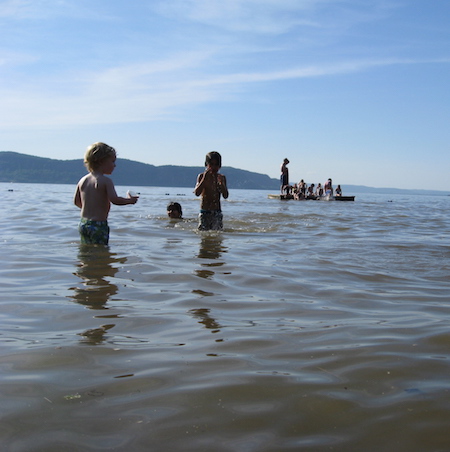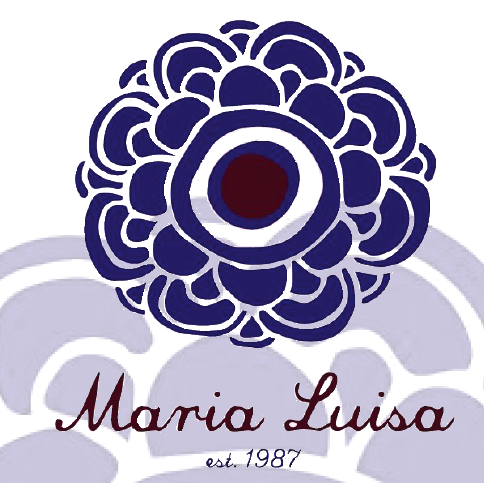by Susan Hellauer
 Earth Matters focuses on conservation, sustainability, recycling and healthy living. This weekly series is brought to you by Maria Luisa Boutique and Strawtown Studio and Blue Rock School and Dying To Bloom, a natural burial boutique for humans and pets.
Earth Matters focuses on conservation, sustainability, recycling and healthy living. This weekly series is brought to you by Maria Luisa Boutique and Strawtown Studio and Blue Rock School and Dying To Bloom, a natural burial boutique for humans and pets. If Earth Matters to you, sign up for our mailing list and get the next installment delivered right to your inbox.
The wettest year around here since 2011 was capped off with a soaking rainstorm from New Year’s Eve right into New Year’s Day. And in Nyack you know that means: another sanitary sewer overflow (SSO) at the waterfront.
In December, Earth Matters ran a story detailing a study by scientists from Lamont-Doherty Earth Observatory (LDEO) and Queens College that showed higher levels of sewage-related bacteria in Hudson River shoreline sediments than in the water itself. High on the list of likely local sources? Repeated SSOs like those at Nyack’s waterfront caused by infiltration of rainwater into the sewer system.
For some backstory on this investigation and its implications for Nyack’s infrastructure and development, Earth Matters spoke last week with one of the study’s researchers, LDEO biological oceanographer Dr. Andrew Juhl.
Earth Matters: How exactly did you measure for sewage bacteria in these Hudson River shoreline sediments? How did you decide what to test for?
Andrew Juhl: We followed EPA guidance, which is based on a consensus of epidemiological studies compiled from many difference sources. This states that enterococcus is the best indicator [of fecal contamination] to use in in brackish waters like those in the Hudson River around here, while both enterococcus and E. coli [Escherichia coli] are both indicated for fresh water. So we used both of these indicator bacteria in this study. We found in the Tappan Zee area that the two were almost perfectly correlated with each other across locations both in the water and in the sediment.

Bacteria from sewage tend to build up in Hudson River sediments, especially mucky ones like this, a new study finds. These researchers from Columbia University’s Lamont-Doherty Earth Observatory were collecting sediment near New York harbor for an unrelated study. (Kevin Krajick/Earth Institute)
The reason that both E. coli and enterococcus give you similar information is that they both come ultimately from the same source: the guts of human beings, predominantly via sewage. They travel hand in hand together, although they are different organisms. They are not the most dangerous fecal pathogens, but they can indicate a recent sewage release, in which other, more harmful sewage-borne bugs might be found.
Nyack’s Hudson River outfall pipe for sewage overflows was ordered closed last year by the New York State Dept. of Environmental Conservation (DEC). Untreated sewage at the Spear Street pumping station now bubbles out of manhole covers and flows into the river at the Nyack marina. In the report on your study, you point out that sunlight and currents help to degrade fecal bacteria in mid-river more quickly than bacteria trapped in shoreline sediment. So, why was it a good idea to close that outfall pipe?
Well, obviously the outfall pipes being closed is increasing the prioritization of this problem in the town, and that’s undoubtedly the right thing. Nyack, as a river village, is trying to redevelop the waterfront, and will greatly benefit from having cleaner water.
A lot of times people look at problems in the Hudson River, and think, “Oh, that’s A) because of its long history of pollution or B) because of New York City, where all the people are.” It makes sense that there would be problems with sewage coming from New York City, but there’s nothing in this study’s data that suggests that this is the case. Both the good and the bad news is that if Nyack’s waterfront has problems with sewage contamination it is Nyack’s problem, and their responsibility to fix it. But they will also be the ones that benefit, because they will see great improvements in water quality.
Have other Hudson River municipalities faced problems like this?
We have seen cases like this in other towns along the river. They’ve taken actions, shut down contamination sources, and the water quality got better. That benefits everybody. It’s a public health issue, but it’s also an economic issue because of all the waterfront housing and development.

Sewage overflow at the Spear Street pumping station on the night of September 26, 2018. Photo: John Gromada
Putting untreated sewage out into the Hudson River in a system like Nyack’s where you have a separated sewer system [as opposed to a combined sewage and stormwater system like Yonkers or NYC] is illegal, and also a health risk. It’s not the way the system is supposed to work. It shows that there is a long-term problem that needs repair.
It sounds like Orangetown and Nyack are doing the right things, and they would probably be more successful with it, except that 2018 was a very wet year. It’s not an excuse, however. There needs to be a system that’s functioning well enough that, even in the very wet year that comes up every five or six, they don’t have bad water quality during those conditions.
But no one should expect an immediate improvement. All these kinds of infrastructure projects take some time. You’ve got all those pipes, and all those homeowners. It’s expensive and it’s complicated. And it’s important for those who are in favor of expanded development to realize that this is a problem that needs fixing. It’s just common sense: a lot more sewer hookups can only make the problem worse.
Earth Matters asked the New York State Department of Environmental Conservation (DEC) about the status of the sewage overflow problem at the Nyack waterfront. Here’s what a spokesman told us this week:
DEC has issued multiple enforcement actions to the Town of Orangetown to address violations and to reduce sanitary sewer overflows in the Nyack area. The town has performed flow monitoring, televising, and smoke testing to identify deficiencies in the sewer system. In addition, the town has undertaken mitigation measures, including sewer lining, for all identified deficiencies.
As a result of DEC’s oversight and these efforts, the annual average number of overflows in the Nyack area has been reduced. DEC is currently evaluating additional measures to reduce these overflows, including storage with treatment.
This sounds like one of those big projects that needs funding from higher levels of government.
In the past there was better government support of projects to build and maintain that kind of infrastructure. Funding from the federal government has dropped substantially in the last couple of decades. The good news is that New York State is making funds available and we hope that communities along the waterfront will take advantage of that.
With the sewage pathogens in near-shore sediments that your study found, should our dogs and kids be playing in the water? Are they going to bring those pathogens home?
I never want to be in the position of suggesting to someone that they shouldn’t take advantage of the Hudson River. It’s our recreational resource. What I suggest rather is that folks be cognizant of the potential hazards.
One of things we see over and over again is the health risk from of sewage contamination after big rain events, If it has rained within last day or two—especially a really heavy rain—maybe that’s not the best time to take the dog to the beach.
People should also know that some places are more contaminated than others. I helped to design a sampling program for Riverkeeper, which uses enterococcus as an indicator, so it is a pretty good reflection of the frequency and levels of sewage contamination along the Nyack riverfront and many other places in the Tappan Zee region. Take a look at their website for sampling results.

Children swimming at Croton Point. Photo credit: Riverkeeper
Some places are fine, like Croton Point Beach where the Riverkeeper sampling history very rarely shows high levels of sewage indicators. Piermont Pier, on the other hand, is very frequently contaminated. So think about where you are going and what risks are associated with that location, and about recent rainstorms.
You can’t put hand sanitizer on your dog, but when my two-year-old daughter goes down to river, she likes to pick up rocks and throw them into the water. That’s fine; but before she sticks her hand in her mouth, I put some hand sanitizer on her. Ideally the water quality would be better, but in the meanwhile I don’t think people should avoid the water. I wouldn’t want to suggest that.
Are any followup studies planned?
We continue to sample at many locations around Hudson River and many parts of the watershed in collaboration with Riverkeeper. You can go to the Riverkeeper website, see the sampling data and keep yourself informed. We sample the Nyack waterfront and Piermont pier throughout the winter.
We also have multiple research projects in progress to better understand things like what sewage bacteria get into the water, how long they persist, how far they get transported, and what other kinds of bacteria are present in addition to sewage indicator bacteria. We are continuing to do research associated with this.
The Town of Orangetown has been using dye testing to help pin down sources of overflow-causing stormwater infiltration, and is investigating incorrect drain and pump hookups to the sewer system. Sewer pipe lining and open cut replacement projects are scheduled for this year.
And then this happened last Saturday (via Supervisor Chris Day’s Facebook page post):
On Saturday night, approximately 150 gallons of fuel oil was dumped into a sump pump at 112 Main Street in Nyack. This sump pump was illegally connected to our sewer lines, and the resulting fumes down the line caused issues at neighboring businesses.
This incredibly irresponsible abuse of our environment is currently being investigated by NYS DEC Police and our Department of Environmental Management and Engineering, and violations and penalties will be issued against the perpetrators in accordance with the law.
Counterintuitively, in this case the illegal connection to our sewer line may have been a blessing in disguise, as the dumped oil would have otherwise ended up untreated in the stormwater system, which would have had significant environmental impact.
Learn more:
- “Sewage Bacteria In Hudson River Sediments” (12/26/18, Nyack News and Views)
- “The Nyack Sewer Blues” (12/5/18, Nyack News and Views)
- Riverkeeper’s Hudson River Estuary water sampling reports

Dr. Andrew Juhl collecting water samples on the Hudson River from the Riverkeeper survey vessel R. Ian Fletcher. Photo: John Lipscomb/Riverkeeper
Email Earth Matters
Read Earth Matters every Wednesday on Nyack News And Views, or sign up for the Earth Matters mailing list.
Earth Matters, a weekly feature that focuses on conservation, sustainability, recycling and healthy living, is sponsored by Maria Luisa Boutique, Dying to Bloom, Strawtown Studio, and Blue Rock School.












